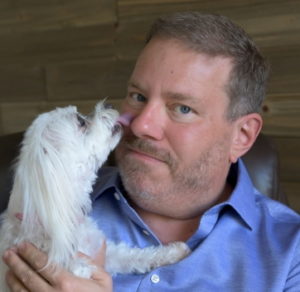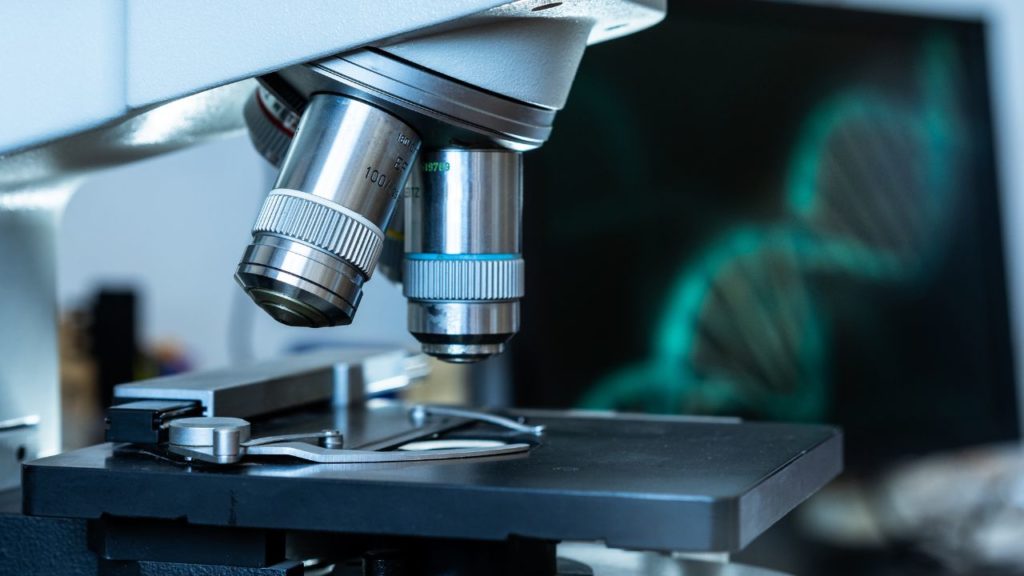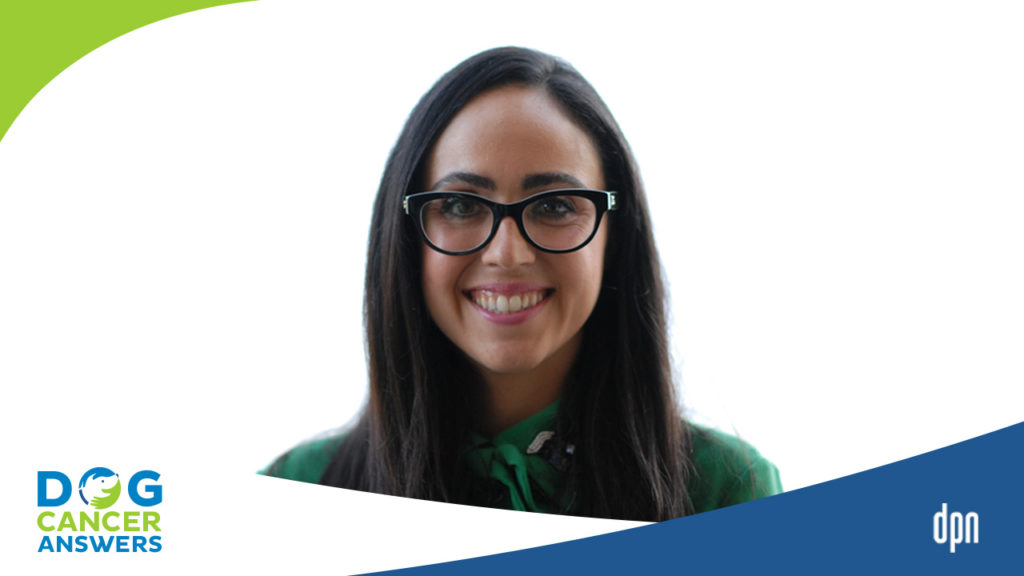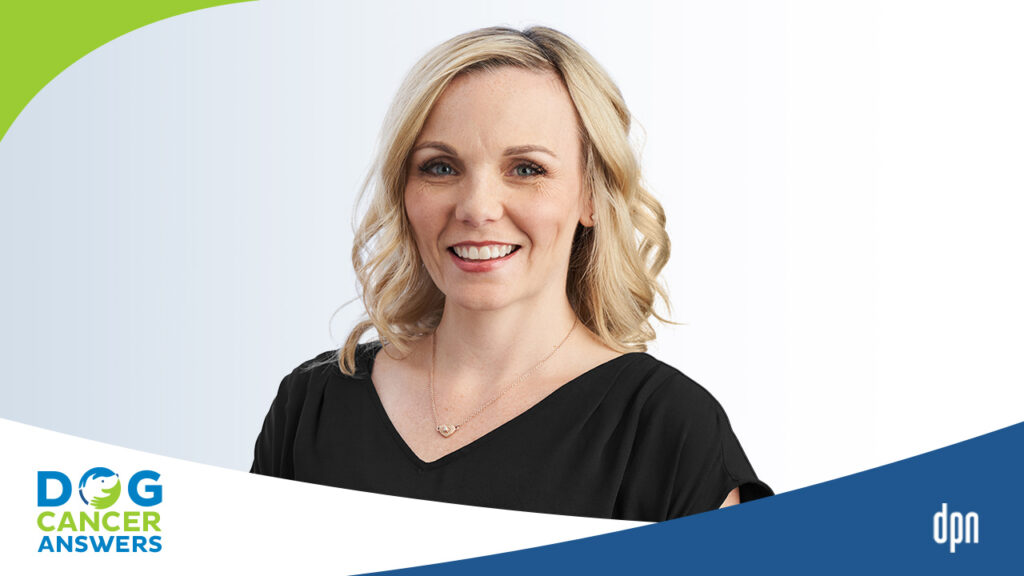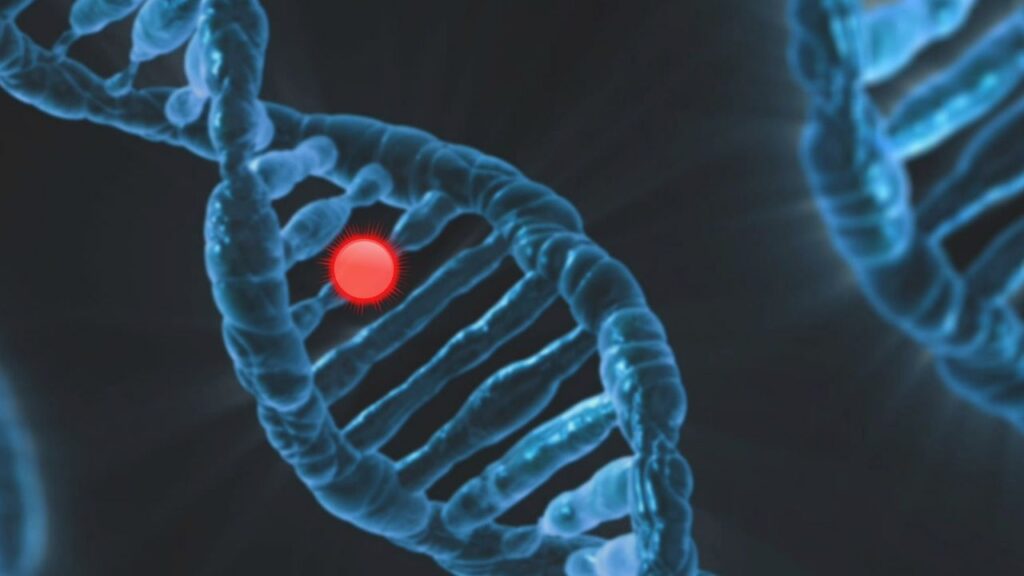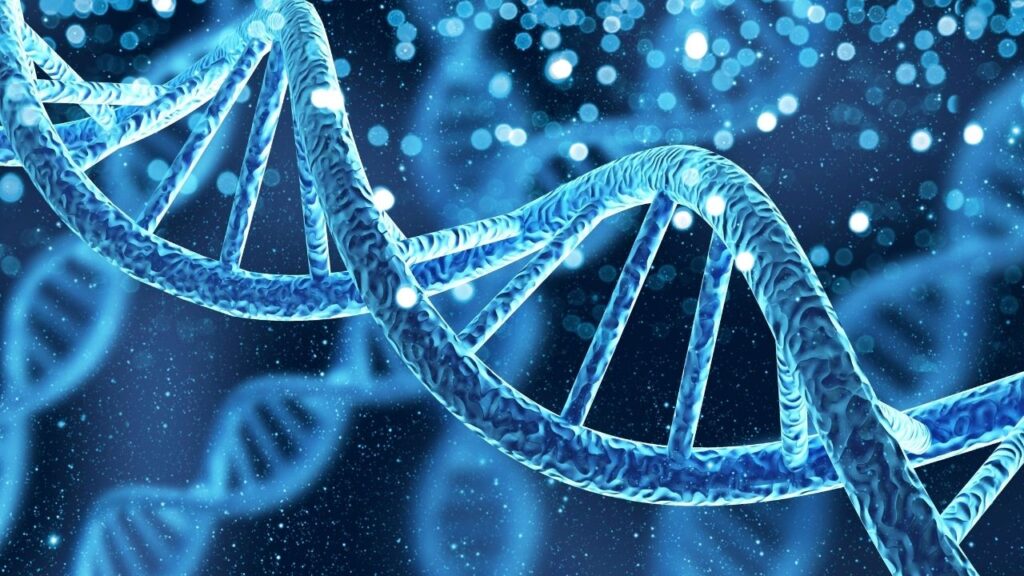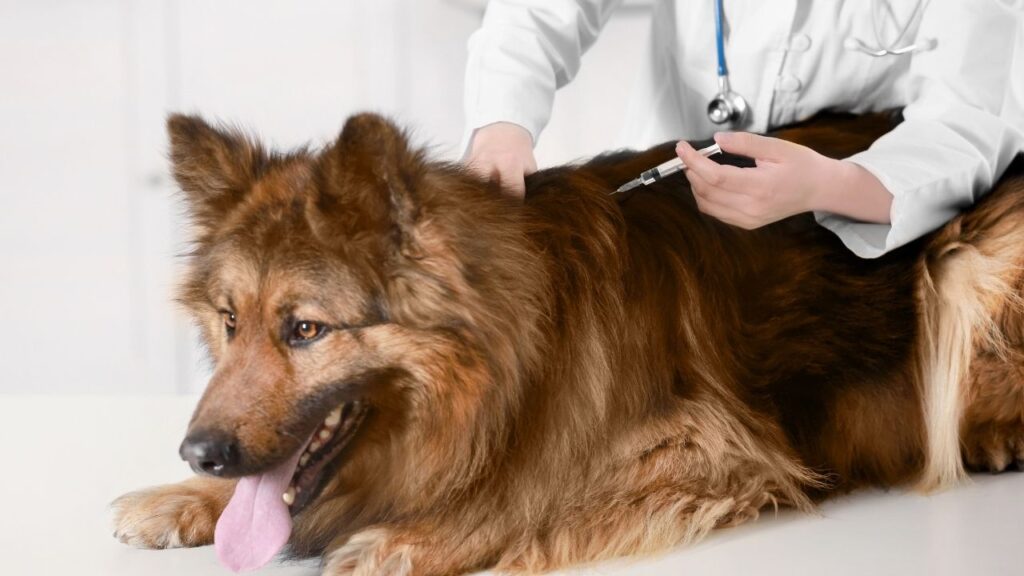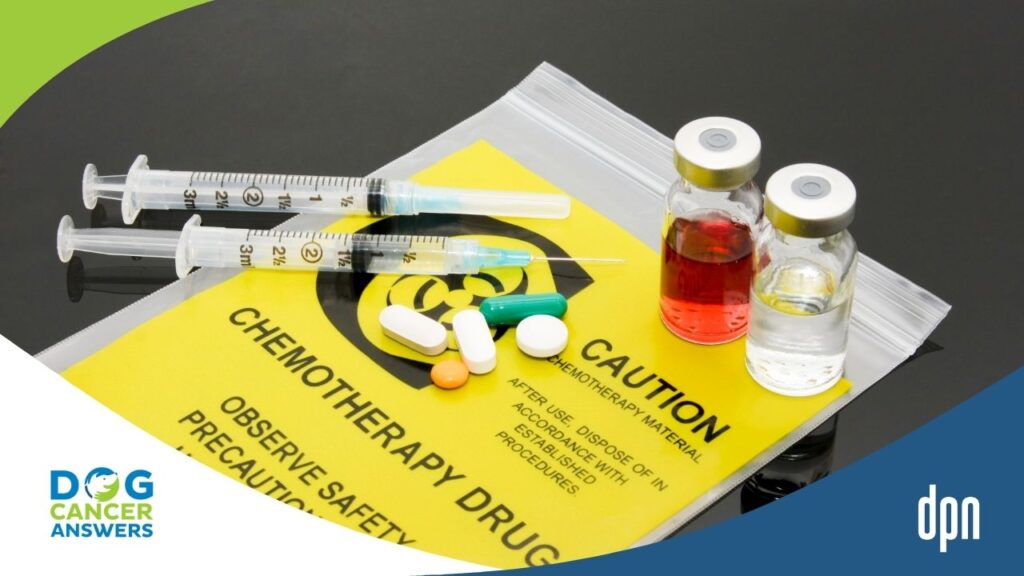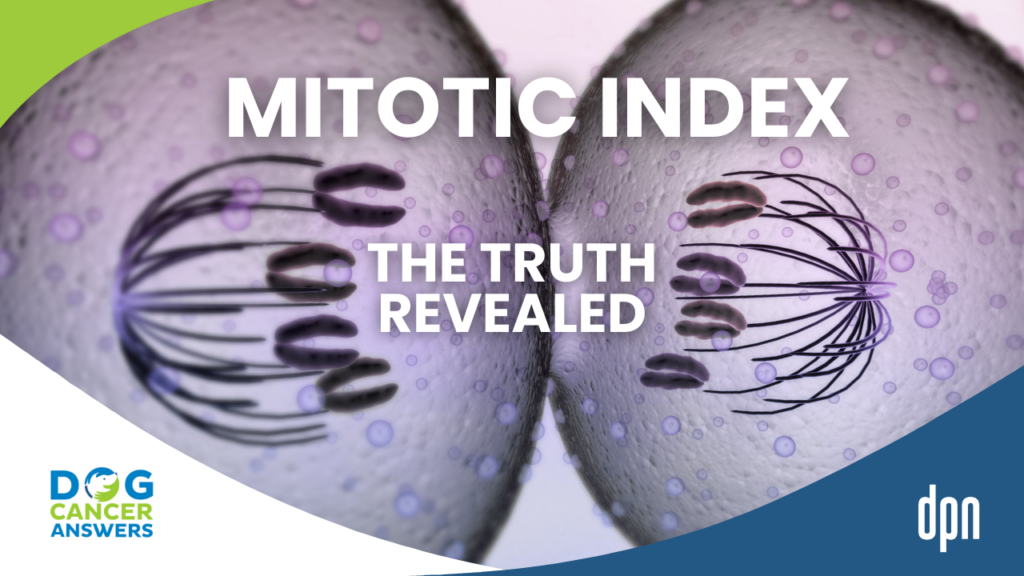EPISODE 161 | RELEASED April 4, 2022
SearchLight DNA Can Find Your Dog’s Cancer Genotype | Dr. Esther Chon
Mutations in your dog’s cancer genotype can point to treatments that will be more effective. Dr. Chon explains how SearchLight DNA works.
SHOW NOTES
SearchLight DNA is a test offered by the company Vidium Animal Health. This test sequences the genome of a dog’s tumor, and then compares that genotype to a database of mutations known to be associated with cancer… and the treatments that target them.
The best part? SearchLight DNA can be done with a simple fine needle aspirate, no surgical biopsy required.
The team at Vidium is made up of oncologists, genomic scientists, and pathologists who all work together on each case. This diverse team emphasizes the importance of using multiple strategies to treat cancer.
Listen in to learn more about SearchLight DNA and how it can be used alongside histopathology to determine the best treatment plan for your dog.
[00:00:00] >> Dr. Esther Chon: Cancers that are really poorly differentiated, where a pathologist or multiple pathologists may have looked at it, put special stains on it, and still not be able to characterize what it is, genomics can really help out there. So there is really a big diagnostic value that SearchLight DNA can also play in this.
[00:00:19] >> Announcer: Welcome to Dog Cancer Answers, where we help you help your dog with cancer. Here’s your host, James Jacobson.
[00:00:27] >> James Jacobson: Hello friends. Genomics is becoming an increasingly important part of dog cancer diagnosis and treatment options, and not just in research labs. There are a few companies that will do DNA sequencing on your dog’s cancer to better indicate what the veterinarian should be doing.
Today, we are speaking with Esther Chon. She is the veterinary affairs manager – director – for a company called Vidium, and they have a process called SearchLight DNA, it’s really interesting. Dr. Chon, thank you so much for being with us today.
[00:01:01] >> Dr. Esther Chon: Oh, thank you for having me.
[00:01:03] >> James Jacobson: So you are a veterinary oncologist who has gone over to the scientific side, in terms of not treating dogs specifically, but working with veterinarians on describing this new DNA testing that, that you guys do. So what is it? What is SearchLight DNA?
[00:01:25] >> Dr. Esther Chon: SearchLight DNA is a genomic panel that looks for mutations in 120 different cancer genes all at the same time, and these mutations can help guide the veterinarian’s overall treatment plan. So it adds a whole wealth of information, genomic information, that will then inform the treatment plan for the veterinarian.
[00:01:52] >> James Jacobson: Now, is this primarily used by oncologists or do general practitioners use it as well?
[00:01:59] >> Dr. Esther Chon: So primarily right now the people that know most about it, I would say, are my colleagues who are veterinary medical oncologists. But we’re certainly opening this up to any veterinarian who will take out a tumor. So that could, you know, there are so many, and in fact, probably over 80% of patients that have tumors or cancers that want to get treated, actually cannot be seen by an oncologist for whatever reason. So we’re trying to include all of those patients and the way to do it is to have general practitioners, primary care veterinarians, have access to this so that it is available to every veterinarian.
[00:02:38] >> James Jacobson: Okay. And I imagine most of the, you know, fine needle aspirates and the biopsies that are done are not done by oncologists, but are done by the general practice vet anyway. So they submit these, or anyone submits the sample to your company?
[00:02:54] >> Dr. Esther Chon: Exactly. That’s the beauty of it.
[00:02:56] >> James Jacobson: So walk us through the process a little bit. What type of samples are eligible to be analyzed by your system?
[00:03:04] >> Dr. Esther Chon: Oh, that’s one of the things that actually got me interested in this company is the fact that we could do it off of needle aspirates, as well as biopsy samples. So needle aspirates are – and I don’t know how much the audience will know about this – but a needle aspirate is basically where you take a needle and you stick it into the tumor, poke it around a little bit, and try to get some cells out of there. Then those cells are then spread onto slides and then submitted to a pathologist to read.
Uh, biopsies on the other hand are chunks of tissue that are taken out, usually fixed in formalin and then embedded in parafin wax, and then read out, sliced and then read out by, uh, by a pathologist. So they’re separate processes, but really the ultimate goal with either of those processes is to figure out whether the patient has cancer, and then what type of cancer it is. So, the beauty of doing a needle aspirate is that most of the time the patient can be wide awake. It’s a very fast process and it’s usually a much quicker and cheaper process. So we’re able to process those samples.
[00:04:05] >> James Jacobson: Do the results, in terms of what you’re able to do with it in terms of the genomic sequencing, make any difference whether it is a fine needle aspirate or a biopsy?
[00:04:14] >> Dr. Esther Chon: No, it does not.
[00:04:15] >> James Jacobson: Okay. A cancer cell is a cancer cell.
[00:04:17] >> Dr. Esther Chon: Exactly. And as long as the DNA is viable – viable, not, not meaning viable in terms of being alive, most of the time they’re, they’re dead, right – but if the DNA is not damaged in any way or fragmented, we can actually then look and evaluate the DNA for these mutations.
[00:04:35] >> James Jacobson: Okay. So let’s talk a little bit about what you are looking at. You said you’re testing it against 120 variants.
[00:04:44] >> Dr. Esther Chon: There are a hundred, 120 genes.
[00:04:46] >> James Jacobson: Genes, genes. Okay.
[00:04:47] >> Dr. Esther Chon: Yes. And we’re looking for different mutations or variants in those genes.
[00:04:53] >> James Jacobson: Okay. And why 120?
[00:04:58] >> Dr. Esther Chon: Those were actually carefully selected by our genomic scientists based off of all of the literature that’s out there to support their association with cancer.
[00:05:07] >> James Jacobson: And is this being done in humans as well? And this is now being ported over to veterinary community?
[00:05:14] >> Dr. Esther Chon: Yes. And that was one of the reasons why I got excited about joining the company as well is because having another tool to better explain what’s going on for, for the patient, and therefore potentially help introduce other therapeutics and give more options for treatment was one of the exciting things about this company. And so, yes, the, uh, Vidium was developed by a genomic scientist, was founded by a genomic scientist, and was to bring over from the human space something that was already being used, to make it available for veterinary patients. So this is equipping veterinarians with another tool to be able to better treat their patients.
[00:05:55] >> James Jacobson: So you’re a boarded oncologist.
[00:05:57] >> Dr. Esther Chon: I am.
[00:05:58] >> James Jacobson: And so when you were studying oncology – when did you graduate from veterinary school?
[00:06:05] >> Dr. Esther Chon: That was back in 2006.
[00:06:07] >> James Jacobson: Okay. So it’s not like, back the eight, 1980s. So you’re relatively recent oncologist. But when you were studying this, did you feel a limitation? Did your professors, did your colleagues feel a limitation by not knowing this type of information about a tumor other than the pathology?
[00:06:28] >> Dr. Esther Chon: Yes. And, um, I don’t feel like I appreciated that limitation way back then, but I certainly, as I continued to practice, I realized that there is a lot more that we need to know. There are better ways to characterize a cancer cell or a cancer period, and that’s by looking at its DNA. We know that cancer is fundamentally caused by mutations in the genes. And so if we have a better understanding of that, then we can have a better understanding of how to treat it as well.
[00:07:00] >> James Jacobson: Well, let’s talk a little bit about the WIIFM, the What’s In It For Me. So, but let’s, more importantly, start with what’s in it for you as an oncologist, and then down the line, what’s in it for the dog?
[00:07:11] >> Dr. Esther Chon: Alright. So what’s in it for the oncologist? Well there’s a lot more information. So the way SearchLight DNA is set up is that we give not only therapeutic information, but we also give diagnostic and prognostic information. So, there’s a, a huge database that undergirds this test and this database pulls from every single publication in the canine literature that has anything to do with cancer genomics.
[00:07:36] >> James Jacobson: And distinguish that from, like normally when you get a pathology report, it doesn’t have any of that information, right?
[00:07:42] >> Dr. Esther Chon: No, it does not. It does not have genomic information on there.
[00:07:45] >> James Jacobson: And it doesn’t have treatment suggestions or literature.
[00:07:48] >> Dr. Esther Chon: It doesn’r either.
[00:07:49] >> James Jacobson: Okay.
[00:07:49] >> Dr. Esther Chon: Yes, yes. It does not. So how SearchLight DNA works is it pulls from this, this database that will match these genetic mutations with a, a biomarker, whether it’s a diagnostic biomarker, a prognostic biomarker, or therapeutic biomarker, and then for the therapeutic biomarkers, we’ll then match to a, an FDA approved targeted therapy in the human space. And so it gives all this information based off of the mutations that are found and pulls all this information from a database. And so depending on what mutations that specific tumor has, uh, we’d be able to give information about the potential therapies that the dog can have to treat the specific cancer.
But for cancers that are really poorly differentiated, where a pathologist or multiple pathologists may have looked at it, put special stains on it, and still not be able to characterize what it is because of how poorly differentiated that tumor is, genomics can really help out there. So there is a really, a big diagnostic value that SearchLight DNA can also play in this.
[00:08:53] >> James Jacobson: Because, speaking from personal experience, I’ve gotten a lot of those pathology reports from my own animals that’re like, it’s kind of undifferentiated. And it makes it sound like the person who did the sample didn’t do a very good job or the, or, you know, and it’s just like, well, that’s kind of, thank you, you’ve not really answered a lot of questions.
[00:09:12] >> Dr. Esther Chon: Mmm. Yes.
[00:09:13] >> James Jacobson: Is that pretty common or am I the, am I rare, am I the rare bird that’s seen that with my own dogs?
[00:09:18] >> Dr. Esther Chon: It’s more common than one may think. So, um, so when, when we get those, it’s extremely frustrating for everybody involved. So the pet parent, as well as the veterinarian, who’s trying their best to put a name on it so that they could appropriately treat it, right? And that’s so important to have a treatment plan, but you can’t necessarily have one without knowing exactly what you’re dealing with. And so that’s where genomics can really help out.
[00:09:42] >> James Jacobson: But I’m imagining using your process, a hundred percent of the time you end up with results.
[00:09:48] >> Dr. Esther Chon: Absolutely. A hundred percent of the time I would say would be best to use it, really because it’s getting all the information that you want possible from a cancer or tumor sample. And the earlier you do it, the better. Because then you have all your options in front of you. This technology that we use is next generation sequencing, and it’s not just the sequencing that needs to be done, but the entire bioinformatics that has to happen afterwards and the analysis of the mutations that needs to happen.
So the turnaround time is very, very quick, but still it takes some time. So it’s about nine to 12 days, and sometimes time is really of the essence for a cancer patient. So, if we get all of this homework done beforehand, at the time of diagnosis really, then that equips all of the veterinarians, whichever veterinarian it might be, the primary care clinician or the specialist, the oncologist who will hopefully end up seeing this patient, has all of the information right at their fingertips.
[00:10:45] >> James Jacobson: Could this replace traditional pathology?
[00:10:48] >> Dr. Esther Chon: I don’t think quite yet. Uh, so we, we use it in conjunction with pathology right now, but eventually…
[00:10:55] >> James Jacobson: But could this replace it? When you say not yet, is this more of a like, well, we don’t want to really mess up a whole branch of veterinary medicine, or is, is there stuff that pathology reveals that this does not reveal?
[00:11:09] >> Dr. Esther Chon: Well, pathology could reveal, you know, what growth rate this cancer might have, that genomics may not necessarily be able to tell us, like the mitotic count. You know, that can be quite informative. It could tell us what the, you know, underlying, uh, cellular origin is if it is differentiated enough, um, which happens in most cases.
But I, I imagine a time in the future where we don’t even need that information anymore. And we can say this is a BRCA2 mutated, just like we do in, for breast cancer. You know, we can sub classify them based off of the genomic mutations that they have. I feel like we are heading in that direction and we potentially can, where we can just name it by the mutation profile that it has.
[00:11:54] >> James Jacobson: That’s pretty exciting. In terms of, like, dog cancer news, that’s kind of exciting. I mean, I never, now I’m asking you to, you know, polish your crystal ball and prognosticate into the future, but how far away is that?
[00:12:06] >> Dr. Esther Chon: Oh my goodness. I think it could be decades away.
[00:12:09] >> James Jacobson: Okay.
[00:12:09] >> Dr. Esther Chon: Maybe. Yeah.
[00:12:10] >> James Jacobson: So the pathologist with the microscope, they’re not gonna lose their, uh, job security just yet.
[00:12:16] >> Dr. Esther Chon: I don’t think so. And I still think that they add value to veterinary medicine, period, not only oncology. Um, so I don’t think that they’ll be out of jobs by any means. And there are certainly non-cancer tumors that we need to look at and that, of course pathologists are necessary for. So.
[00:12:34] >> James Jacobson: Okay. So this goes hand in hand with pathology, but do you need more sample material in order to send stuff to pathology as well as to sequencing?
[00:12:44] >> Dr. Esther Chon: Yeah. So the normal workflow is actually, let’s figure out whether this is a malignancy or not. And so, you know, we want to work with malignant tumors, not benign tumors, and so first figure out whether it’s malignant or not with a biopsy or an aspirate, so, and sent to a pathologist. And then once we do figure that out and the, the clinician would like to know the underlying genomics of that tumor, then they’ll order SearchLight DNA, and then that tumor will then be transported over to the Vidium Animal Health Lab. And then we’ll process it and extract the DNA and then run next generation sequencing on that. So that’s the normal pathway.
[00:13:22] >> James Jacobson: Okay. And you say it takes about 12 days for the sequencing.
[00:13:27] >> Dr. Esther Chon: 9 to 12 days. And our, and our average has been actually less than 10 days.
[00:13:31] >> James Jacobson: Okay. So let’s talk a little bit about the database, ’cause you said the database is a real special part of this process. What is constituted in the database? What’s in it? ‘Cause it’s a bunch of stuff. It’s not just like one thing.
[00:13:46] >> Dr. Esther Chon: No, it’s a, it’s a bunch of stuff. So right now all of the information that’s out there in the literature, in the canine literature, is curated and put into this database. All the variations that we’ll see in the different genes that we’re looking at will be stored in this database. So that if there is a mutation that we find, then it could pull directly from that database to say, Hey, this gene and this particular mutation in this particular gene, was associated with this kind of tumor, or was associated with this kind of a prognosis, or it was matched to this drug.
And so it will pull automatically from this database. But we also, in this database, have human data as well, from the, the high impact studies that are out there for these genes. And so we pull from the human space as well and make inferences from there where, where, especially where we, we still have gaps in the, in the, in the canine data.
[00:14:46] >> James Jacobson: Okay. And then going back to the WIIFM for the veterinarian, because in the old days, back when you were practicing a year ago, when you would get the pathology, you, you were relying on the database between your ears, right?
[00:15:00] >> Dr. Esther Chon: Right.
[00:15:01] >> James Jacobson: I mean, you obviously had literature, you had computers and stuff like that, but you had to do a lot more work.
[00:15:06] >> Dr. Esther Chon: Yes. And that, that’s another thing that, where that’s one of the messages that we have is we are basically a portal to all of that genomic information out there. And any veterinarian will know that there is so much information that we have to keep up with on a daily basis. And then if you add genomic information on top of that, which, you know, the field of genomics is relatively new for us, that is an overwhelming amount of information on top of the enormously busy schedules that we have.
And so what we want to do is make it as easy as possible for everybody involved. And since we are a diagnostic company, we work very closely as the veterinary care team, with the veterinary care team, and so one of the ways that we can make it as easy as possible for the veterinarian to interpret this information is to be that portal and to summarize that information in a very digestible manner. But we also provide consultations for the veterinarians to dive deeper into these reports.
[00:16:02] >> James Jacobson: We’re gonna take a break right now, but when we come back, Dr. Chon, I want to ask you a little bit about the other side of the WIIFM, what the benefits are to the dog. We’ll be right back.
We are back with Dr. Esther Chon. Dr. Chon, I wanted to ask you a little bit about what the benefits are for this sequencing for the patient, for the dogs?
[00:16:26] >> Dr. Esther Chon: Oh yes. There is actually a lot of benefit, aside from being able to give a name to something that you may not have a name for. And by dog, I’m assuming that you also mean the pet parent.
[00:16:38] >> James Jacobson: Yes we do. Yes.
[00:16:39] >> Dr. Esther Chon: Okay.
[00:16:40] >> James Jacobson: But the end beneficiary of this really is the dog.
[00:16:43] >> Dr. Esther Chon: Is always the dog, correct. Correct. And so, the information that a clinician would most be interested in is what can I do with this information? How can I treat my patient? Right? And so the therapeutic information that we could provide can go quite a long way and is probably what the pet parent is most interested in.
And so if there is a match to a drug, these drugs are targeted therapies that are actually oral drugs that the owner would be giving to the patient, to the dog, on a daily basis, or sometimes twice a day basis depending on what the drug is. And so that takes out the visit to the veterinarian that could sometimes be quite stressful for the patient.
Their own owner is giving them the medication and not somebody else. And it’s all being done at the comfort of their own home. So that, I think, provides, in and of itself, uh, you know, just, just taking the, the doctor visit away for the treatments is I think a huge benefit to the patient directly. And of course, by extension, the pet parent, who doesn’t have to make that drive, take a half day off work, and go over there for a chemotherapy injection. That takes that stress factor out. And still be able to benefit from the therapy in terms of their cancer burden going down, if there is efficacy of that cancer drug.
[00:18:03] >> James Jacobson: So you guys are not alone in this, in this area of DNA sequencing for dogs, that, another company that we hear a lot about is FidoCure and, you know, there’s some others as well. How does what you do, how is that distinguished from these other competitors of yours?
[00:18:20] >> Dr. Esther Chon: Yes. So in several different ways, one is that we have an internal lab, so we don’t outsource our analyses, or the assay itself, out to any other labs. So we have direct control over everything that we are doing. I have never seen a lab that has so much quality assurance measures put in place. They’re very hard on themselves and I’m glad they are very rigorous in what they do, but that also allows us to have the flexibility to expand and pivot our tests to the needs of the community. So if there is another gene that we identify that is very important, we can easily include it. We can version our tests and even our reports, which actually we’re in the process of doing right now to accommodate for those changes very easily.
Another thing is that we’re very proud to be able to provide more than just therapeutic biomarker information. Diagnostic and prognostic biomarker associations are made in our test as well and reported in our assay, and so that, we’re very proud of that as well. 120 different genes, which is an, I think an impressive number of genes that we cover, and many different mutation types within those genes.
We can process aspirates, as well as biopsy samples. And then we also have multiple disciplines within our team. And so it’s not a genomic scientist that’s trying to do all of the work by themselves as an island. We have me, the medical oncologist, we have several genomic scientists, but we also have pathologists who always put our heads together, talk about these cases together to come up with a well-rounded report.
[00:20:03] >> James Jacobson: So this isn’t just being spit out by an AI. There’s a lot of human consultation that the veterinarian is receiving as a result of this process, from a brain trust of people.
[00:20:13] >> Dr. Esther Chon: There is, there is almost like a, uh, there there’s a lot of conversation that happens behind the scenes that nobody knows about because they’re not in it. So it’s a multi-disciplinary effort with this test.
[00:20:25] >> James Jacobson: So let’s go back to maybe some anecdotal, or some case studies where you had a dog who has been diagnosed through this process, and you did the sequencing, and you were able to come up with something that you might not have been able to do if you just relied on pathology.
[00:20:43] >> Dr. Esther Chon: Oh, yes. So one example that comes to mind is a very young dog that actually had a really large oral mass. And this was a mass that was on the hard palate right next to one of the molars. Um, and so that’s a very difficult area to get to, to surgically excise. The surgeon did actually try to go in and take out as much tumor as possible, but because of how vascular and full of blood vessels this mass had, he wasn’t comfortable in, in trying to scoop out the base of the mass. And so took out as much as he could, submitted that for a histopathology evaluation, the pathologists could not determine what it was. It was a poorly differentiated tumor.
So we did some genomic analysis on it. And so just to preface that, you know, some of the most common oral tumors that we see in dogs is melanoma, sarcomas, and squamous cell carcinomas. And those three can have very different adjunctive therapies. So primarily we say, if there’s no evidence of spread of the disease and, then try to take it out surgically. Not everyone is happy to do that when it’s all the way up here that requires removal of part of the jaw and part of the hard palate.
And so it could be quite an extensive surgery. But whether you follow up with radiation therapy, or immunotherapy, or high-dose chemotherapy – and even with radiation therapy, what kind of scheme do you use? It will depend on what the tumor type is. So not having a name to this could really hinder what therapeutic plan the oncologist or the veterinarian will want to pursue.
So with this particular patient, not knowing what it was, we actually did some genomics on it and found a point mutation in the BRAF gene. And so that particular point mutation actually then pointed to a whole list of different targeted therapies. And one of those drugs actually was very easily accessible and available through several of the major veterinary compounding pharmacies in the United States.
And so this owner who initially had no idea what this, what this tumor was, and actually did not want to pursue any major surgery or radiation therapy or chemotherapy, now had a drug that she could give to her dog at home. And we actually followed up with this patient, and it’s only been about a month out since starting this drug, and the drug was Trametinib, it’s a MEK inhibitor, so it inhibits part of that pathway that’s mutated in this patient’s tumor. And the the tumor had actually regrown after the surgery, and then she started the therapy and it came down in size by more than 50%.
[00:23:21] >> James Jacobson: Which again, as listeners to this show will know, to an oncologist that is like a radical success. It’s awful but-
[00:23:28] >> Dr. Esther Chon: Oh my gosh. It’s amazing. It is, it is amazing. Especially for an oral tumor that’s poorly differentiated. We know these guys can be quite aggressive, whatever it is, it’s poorly differentiated. So, um, so that’s, that’s such a huge success story and I can think of even several others out there, if you want to know more.
[00:23:45] >> James Jacobson: Sure do another, let’s do another one.
[00:23:47] >> Dr. Esther Chon: Oh, okay. Um, so I have, another one that resonates deeply with me is, is a dog that, actually middle-aged dog, that had lymphoma, multicentric lymphoma, which is one of the most common tumor types or cancers that we see. And, and so this is where the peripheral lymph nodes are enlarged and plus or minus the liver and spleen, and sometimes also the bone marrow. But this patient had lymphoma and, uh, the most common type of therapy is chemotherapy. And it’s a multi-agent chemotherapy, uh, with the acronym CHOP. So there is no chopping involved, but CHOP stands for the drugs that are involved. And the C H O are the chemotherapeutics, and P is prednisone for the steroid that’s also included in this protocol. So it’s multi-agent and it’s given on a weekly basis, and it’s usually a 19 to 25 week protocol, depending on what protocol is chosen with CHOP based protocol. But for this particular patient after the fourth week, which is usually around the time they’ve already seen all the major chemotherapy drugs, the lymphoma was already progressing.
So it was already starting to not listen to the chemotherapy.
[00:24:54] >> James Jacobson: Which is pretty common for lymphoma.
[00:24:56] >> Dr. Esther Chon: It is common. It’s actually, I want to say pretty common to have them do better than the four weeks, you know, but, um, some of them can be quite aggressive, and eventually a lot of these lymphomas, as you said, do come out of remission.
And so this patient came out sooner than we, than we expected. And so by five week, the lymphoma was progressing, the first rescue therapy was pursued, after one dose the patient progressed. After another chemotherapeutic agent, rescue agent, was chosen and was given, the patient progressed again. And so we were quickly running out of options, but thankfully SearchLight DNA was pursued and there was a match for a drug called Olaparib based off of two different mutations actually – one was a BRCA1 mutation and another was a CDK12 mutation, and both of these genes have, um, are heavily involved with DNA repair.
Anyway, so, so these mutations pointed to a drug called Olaparib. The patient was put on Olaparib, tolerated it extremely well, and went into a complete remission within six days, and then stayed that way for a month.
[00:26:01] >> James Jacobson: Wow.
[00:26:01] >> Dr. Esther Chon: Which is actually unheard of for a lymphoma that is so resistant to so many different chemotherapeutics. So another success story there, and the drug again was given by the owner once a day, and no toxicities, and tolerated well.
[00:26:15] >> James Jacobson: Well, let’s talk about the drugs in general, the therapeutics that are being suggested, because these are not – these are off-label use, they’re not designed specifically for use in veterinary care. They’re being done off label. Explain that.
[00:26:28] >> Dr. Esther Chon: Correct. So these are actually FDA approved for humans. And so when they’re fully licensed, then we are able to use them in other species off-label. So off-label purely means that, you know, dogs are not on the label for use. And you can say that about all of the chemotherapies that we use, the conventional chemotherapies, Doxorubicin, Vincristine, you know, Cyclophosphamide, all of those drugs are actually used off label because-
[00:26:54] >> James Jacobson: Because there are really only two drugs that, like Palladia, and, there’re just only a couple that are specifically for veterinary use.
[00:27:01] >> Dr. Esther Chon: Correct. Correct. You know, very, very small number. Right. And so we do depend on the, the ability to use these other drugs off label, just because of how few are actually, have gone through the whole process of becoming FDA approved. So these drugs are used off label, but most of the time used quite successfully off label.
[00:27:21] >> James Jacobson: And they’re used for cancer in humans. Let’s discuss a little bit the role of the compounding pharmacy and why that’s important if these are FDA approved products.
[00:27:31] >> Dr. Esther Chon: Right. So the, the weights of these dogs can be quite, quite variable, as it can be for humans, but most of the time for humans, you can say, Hey, you know, you, you can be given 500 milligrams of this twice a day, that’s the label for an average adult. There is no average size, for a, for a dog, you know, a Chihuahua versus a Great Dane will have very different absolute doses that are required. And so we, we do need the compounding pharmacies to be able to make these drugs into doses that are acceptable for, for the patient.
So, you know, a Chihuahua will have a very different dose than, than a Great Dane, so we want to be able to accommodate all of these variations in their sizes. And so the compounding pharmacy will make that happen.
[00:28:17] >> James Jacobson: Let’s talk a little bit about dollars and cents. How expensive is this?
[00:28:21] >> Dr. Esther Chon: So it really depends on the drug.
[00:28:23] >> James Jacobson: Talk about the drugs, but I meant, I meant SearchLight DNA.
[00:28:25] >> Dr. Esther Chon: Oh SearchLight DNA. Okay. Very good question.
[00:28:28] >> James Jacobson: But we can do the drugs first because the drugs are all gonna be based on – ’cause there are some very expensive cancer therapeutics, and some more reasonable cancer therapeutics. Are the ones that you’re recommending, are they all over the world or?
[00:28:41] >> Dr. Esther Chon: They are all over the map in terms of cost, but I would say overall, they are cheaper than conventional chemotherapeutics. So-
[00:28:51] >> James Jacobson: Really.
[00:28:51] >> Dr. Esther Chon: It really depends on which drug you’re talking about. And it really also depends on the compounding pharmacy too. I mean, they will have their own set prices for what they charge, but overall, for example, you know, one dose of chemotherapy could cost anywhere between $500 to $800, whereas one month supply of one of these targeted therapies can be probably less than $300, depending on what it is of course.
[00:29:15] >> James Jacobson: A little bit easier for the dog to tolerate ’cause there’s no IV there’s none of that stuff.
[00:29:19] >> Dr. Esther Chon: Yeah. Yeah. And that actually, you bring up a good point there, if you don’t mind my interjecting here, that it is actually also easier on the veterinarian, because if we’re talking about high dose chemotherapy, like Doxorubicin or Vincristine, that needs to be drawn up.
It’s a liquid that needs to be drawn up into a syringe and then given through an IV catheter into the vein of a patient. You can imagine the potential exposure to the personnel who’s drawing it up too, right. So for injectable chemotherapies, we want to have certain safety measures in place, such as a biosafety hood, PPE, so personal protective equipment like a gown and goggles and gloves. And then also, uh, closed system transfer devices that will allow for, or minimize the potential for any of these to aerosolize. And so all of that is obviated by having these drugs that the owner can give at home, um, just with, with gloves, orally.
[00:30:14] >> James Jacobson: I imagine that’s probably one of the benefits that you experienced in your own life at Vidium – you don’t have to put on that PPE and you don’t have to be exposed to those carcinogenic agents.
[00:30:23] >> Dr. Esther Chon: Exactly. And, and just for a little bit of clarification here, and I think when, but hearkening back to your previous question is, you know, we, we differ from other companies out there in the field also from the fact that we’re a diagnostic company. We’re a genomic diagnostics company, we’re not a drug company. So while there could be matches to these drugs, we don’t actually source the drugs. However, one thing we do is make sure that we give as much information about the drugs – including where you can get them and what the costs might be. So we don’t leave the vets hanging. Uh, we say, Hey, they match to these drugs, but these drugs can be found here and you could get them very easily, you know, by calling XYZ.
[00:31:04] >> James Jacobson: So you give them choices so they can, yeah.
[00:31:06] >> Dr. Esther Chon: Exactly.
[00:31:07] >> James Jacobson: It’s all part of the database. So let’s get to the dollars and cents of what it costs to get a SearchLight DNA report.
[00:31:14] >> Dr. Esther Chon: Right. So, because we’re actually a part of the vet team, we’re a diagnostic company, we actually sell directly to the veterinarian. So the veterinarian will then charge the client. So how much the veterinarian will charge the client is totally dependent on what kind of pricing structure that the particular hospital or clinic may have.
[00:31:35] >> James Jacobson: You know I’m not going to let you get away with that. So a little bit, like, I mean, we know that vets have overhead and margin and all that stuff.
[00:31:41] >> Dr. Esther Chon: Yes. Exactly.
[00:31:42] >> James Jacobson: But what does it cost a veterinarian?
[00:31:43] >> Dr. Esther Chon: So we charge the veterinarian under a thousand dollars.
[00:31:47] >> James Jacobson: Okay.
[00:31:47] >> Dr. Esther Chon: But then what the range that I have seen out there from hearing from my colleagues, as well as general practitioners, is between $1,000 and $2,000 roughly.
[00:31:56] >> James Jacobson: Well, and that’s fair. I mean, we, we know that vets have a business. They gotta keep the doors open, but if we’re starting at $10,000 dollars…
[00:32:02] >> Dr. Esther Chon: No, no, no.
[00:32:03] >> James Jacobson: Yeah, yeah. So their costs are relatively reasonable in the schema of dog cancer.
[00:32:09] >> Dr. Esther Chon: Oh, absolutely. And, and if you think about all the money that you could be saving by not doing chemotherapeutics, you know, the conventional chemotherapeutics – and this is not to say that it should wholly replace chemotherapeutics, I think there certainly is a place for it. And I think time will tell and further studies will tell us whether targeted therapies are better or worse or on par with conventional chemotherapies. Or maybe used in conjunction with chemotherapeutics, right? So there’s, there’s definitely a learning curve there. Um, with time, hopefully we’ll be able to get those answers. But sometimes owners just can’t afford conventional chemotherapy, or they can’t go to an oncologist near them. You know, there are several states out there that don’t have an oncologist in the state.
And even if you did have an oncologist in the state, the wait times can be atrociously long. I’ve heard in Minnesota, one of my primary care veterinary friends said the wait was six months. That’s just way too long to see an oncologist. And so, and my wait times when I was in practice was about two months. And so that’s, that’s a really long time and we’re working at warp speed here and still unable to see all of them.
So, so we’re able to provide something quicker and potentially be able to give a therapeutic option for those that, that might not have it, and also potentially give a cheaper option for those that may still have chemotherapy in mind, and not ruling it out at all, but still giving another option.
[00:33:38] >> James Jacobson: And I think we need to mention that, because obviously the skeptics to these targeted therapies site that well, you know, these targeted therapies sound interesting, but we kind of know what chemo success rate is, and in some cases, traditional CHOP protocol or whatever has better results based on what the data shows, right?
[00:34:00] >> Dr. Esther Chon: There could be. I don’t think that data is quite out there yet. And so there, definitely, there are skeptics out there, but we really want to be able to give options to clients who may not necessarily want to pursue the standard of care, or perhaps standard of care has failed, or they just don’t want standard of care because of cost or logistics or what have you. So, um, so we want to give all of those options out there, but there are those that want to hear all the options out there, including standard of care.
And that’s really leaving no stone unturned. And so having all of the options and being able to give all the options, that’s what we’re about.
[00:34:40] >> James Jacobson: That is a perfect way to conclude this because of, that’s what you’re providing, is options. Esther Chon from Vidium, thank you so much for being with us today.
[00:34:49] >> Dr. Esther Chon: You’re welcome. Thank you for having me.
[00:34:51] >> James Jacobson: So finding out what is inside of your dog’s cancer cells can be really important. I think this is definitely the future and it gives us all options. And we are gonna continue to cover this here on Dog Cancer Answers. I want to thank you for joining us today, whether you joined us on video by watching us on YouTube or listen to us in your ears on one of our podcast channels.
Thank you so much for being with us. If you found this episode helpful, please do us a favor and share Dog Cancer Answers with your friends and perhaps your veterinarians, because the more people who know about this show, the more influence we can have in terms of getting people this information when they have dogs with cancer.
Well, that is it for today. I’m James Jacobson, on behalf of all of us here at Dog Podcast Network, I’d like to wish you and your dog a very warm, Aloha.
[00:35:50] >> Announcer: Thank you for listening to Dog Cancer Answers. If you’d like to connect, please visit our website at DogCancerAnswers.com, or call our Listener Line at (808) 868-3200. And here’s a friendly reminder that you probably already know: this podcast is provided for informational and educational purposes only. It’s not meant to take the place of the advice you receive from your dog’s veterinarian. Only veterinarians who examine your dog can give you veterinary advice or diagnose your dog’s medical condition. Your reliance on the information you hear on this podcast is solely at your own risk. If your dog has a specific health problem, contact your veterinarian.
Also, please keep in mind that veterinary information can change rapidly, therefore, some information may be out of date. Dog Cancer Answers is a presentation of Maui Media, in association with Dog Podcast Network.
Hosted By
SUBSCRIBE ON YOUR FAVORITE PLATFORM
Topics
Editor's Picks
CATEGORY

